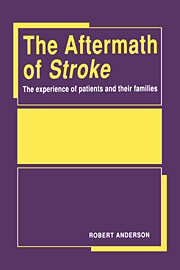Book contents
- Frontmatter
- Contents
- Acknowledgements
- Chapter 1 Stroke: An introduction to the problem
- Chapter 2 The Greenwich stroke study
- Chapter 3 Coming into medical care: the first month after stroke
- Chapter 4 Hospital care and rehabilitation
- Chapter 5 Survival, physical disability and health
- Chapter 6 Support in the community
- Chapter 7 The effects of stroke on social, family and personal life
- Chapter 8 Caring and coping with stroke
- Chapter 9 Resources for coping with stroke
- Appendix: Measurement and scoring of variables
- References
- Index
Chapter 4 - Hospital care and rehabilitation
Published online by Cambridge University Press: 07 October 2011
- Frontmatter
- Contents
- Acknowledgements
- Chapter 1 Stroke: An introduction to the problem
- Chapter 2 The Greenwich stroke study
- Chapter 3 Coming into medical care: the first month after stroke
- Chapter 4 Hospital care and rehabilitation
- Chapter 5 Survival, physical disability and health
- Chapter 6 Support in the community
- Chapter 7 The effects of stroke on social, family and personal life
- Chapter 8 Caring and coping with stroke
- Chapter 9 Resources for coping with stroke
- Appendix: Measurement and scoring of variables
- References
- Index
Summary
Most stroke patients spend some time in hospital, but almost nothing is known about their daily experiences there, about their attitudes to care and to hospital life, or about their main worries, concerns or aspirations. This curious vacuum in information may reflect considerable hesitation among professionals about how much they want to know, and an ambivalence and uncertainty among doctors, therapists and nurses about what they can do that will improve the lives of stroke patients. Medical attitudes to the management of stroke and to rehabilitation appear to have been characterised by an ‘air of pessimism’. It has been suggested that stroke inspires ‘therapeutic nihilism’ (Norris and Hachinski, 1982) and that, in general, doctors exhibit a lack of interest in stroke rehabilitation: ‘[it] is often considered to be something that other people do when the doctor has become therapeutically bankrupt … the suggestion has been made that patients should not be subject to unwanted activity but be left in peace to die in dignity’ (Mulley, 1981, p. 24). In a study of the management at home of stroke patients, Isaacs and colleagues (1976) found that general practitioners made a limited contribution; this they attributed, in part, to the pessimistic attitude to stroke rehabilitation which prevailed in hospitals at the time when these doctors received their training. There are no data about the current attitudes of either general practitioners or hospital doctors, although the development of stroke units suggests that some doctors at least may have more optimistic views.
- Type
- Chapter
- Information
- The Aftermath of StrokeThe Experience of Patients and their Families, pp. 59 - 87Publisher: Cambridge University PressPrint publication year: 1992



